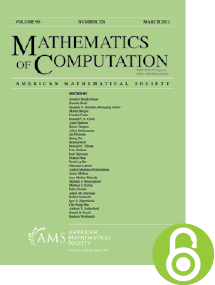K3 surfaces with Picard number three and canonical vector heights
HTML articles powered by AMS MathViewer
- by Arthur Baragar and Ronald van Luijk PDF
- Math. Comp. 76 (2007), 1493-1498 Request permission
Abstract:
In this paper we construct the first known explicit family of K3 surfaces defined over the rationals that are proved to have geometric Picard number $3$. This family is dense in one of the components of the moduli space of all polarized K3 surfaces with Picard number at least $3$. We also use an example from this family to fill a gap in an earlier paper by the first author. In that paper, an argument for the nonexistence of canonical vector heights on K3 surfaces of Picard number $3$ was given, based on an explicit surface that was not proved to have Picard number $3$. We redo the computations for one of our surfaces and come to the same conclusion.References
- Arthur Baragar, Canonical vector heights on $K3$ surfaces with Picard number three—an argument for nonexistence, Math. Comp. 73 (2004), no. 248, 2019–2025. MR 2059748, DOI 10.1090/S0025-5718-04-01661-8
- Joseph H. Silverman, Rational points on $K3$ surfaces: a new canonical height, Invent. Math. 105 (1991), no. 2, 347–373. MR 1115546, DOI 10.1007/BF01232270
- John T. Tate, Algebraic cycles and poles of zeta functions, Arithmetical Algebraic Geometry (Proc. Conf. Purdue Univ., 1963) Harper & Row, New York, 1965, pp. 93–110. MR 0225778
- R. van Luijk, An elliptic K3 surface associated to Heron triangles, J. Number Theory (to appear); available at arXiv:math.AG/0411606 (2004).
- R. van Luijk, K3 surfaces with Picard number one and infinitely many rational points, preprint, available at arXiv:math.AG/0506416 (2005).
Additional Information
- Arthur Baragar
- Affiliation: Department of Mathematical Sciences, University of Nevada Las Vegas, Las Vegas, Nevada 89154-4020
- Email: baragar@unlv.nevada.edu
- Ronald van Luijk
- Affiliation: Mathematical Sciences Research Institute, 17 Gauss Way, Berkeley, California 94720-5070
- Address at time of publication: Department of Mathematics, Simon Fraser University, 8888 University Drive, Burnaby, BC V5A 1S6, Canada
- Email: rmluijk@gmail.com
- Received by editor(s): February 22, 2006
- Received by editor(s) in revised form: July 14, 2006
- Published electronically: January 24, 2007
- Additional Notes: The first author is supported in part by NSF grant DMS-0403686.
- © Copyright 2007
American Mathematical Society
The copyright for this article reverts to public domain 28 years after publication. - Journal: Math. Comp. 76 (2007), 1493-1498
- MSC (2000): Primary 14G40, 11G50, 14J28, 14C22
- DOI: https://doi.org/10.1090/S0025-5718-07-01962-X
- MathSciNet review: 2299785


